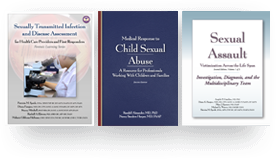Professionals working in the field of child sexual abuse have an important task. They should be dedicated to help abused children and their families in the best possible way. This means that talking to children, performing the examination and tests, interpreting findings and results, and providing therapy should be based on best practice and scientific evidence. This text offers an excellent evidence based resource for the complete workup of sexually abused children in a multidisciplinary approach. This book also provides information about abused children with disabilities, child sexual exploitation, prevention, and the court process. Every professional working in this field should be familiar with this textbook.
Wouter A. Karst, MD
Forensic Physician
Netherlands Forensic Institute
The Hague, Netherlands
A valuable text for medical providers (physicians, forensic nurses, and advance practice providers) whether novice or expert, who provide care to children, adolescents, and their families when there is a suspicion of sexual abuse. Dr. Finkel provides meticulous detail describing elements of the medical history, components of the examination, screening for trauma symptoms, the value of anticipatory guidance on personal space and safety, and the mandate for precise and accurate medical documentation. An updated review is summarized regarding the collection and testing of items with potential evidentiary value with a forward focusing lens. Dr. Kellogg contributes a thorough blueprint on the testing, imaging, treatment, and reporting of STIs in addition to a valued approach to providing care to adolescents with concerns of sexual abuse. Dr. Nazer provides a detailed course on the structures of the genitalia and Dr. Adams provides the most recent information regarding the interpretation of medical findings in suspected child sexual abuse. This book is valuable to all members of the multidisciplinary team providing care, comfort, investigation, guidance, and resolution for children and adolescents affected by child sexual abuse.
Sonja Eddleman, MSN, RN, SANE-A, SANE-P
Child Abuse Resource and Evaluation (CARE) Team
Clinical Coordinator
Driscoll Children’s Hospital
Corpus Christi, Texas
Readers across multiple disciplines—including healthcare providers, social workers, child protection teams, legal professionals, and law enforcement—will find this text highly relevant. The necessity of a multidisciplinary team to optimally care for children who have experienced sexual abuse and recommendations for the role of each team member are outlined. All disciplines will find practical applications for the information in chapter 3: “The Medical Evaluation of a Suspected Child Abuse Victim.” This chapter details key elements to approaching the child victim and family, the specifics of the history and physical exam, and highlights legal aspects of documentation with specific examples provided. Notably, this text ends with a review of the effects of sexual abuse on the genetic/epigenetic level of the brain and highlights the long term psychological and health consequences. For all who care for children and families affected by sexual abuse, I highly recommend this text as an engaging and thorough resource.
Kelly C. Dauk, MD
Professor of Pediatrics
University of Louisville School of Medicine
Louisville, Kentucky
Dr. Alexander and Dr. Harper provide a bright and fast-moving discussion covering a wide expanse of multidisciplinary history, describing society’s concept of the disease of child sexual abuse around the globe. The chapter maintains an optimistic tone even in the realistic criticism of past missteps and frames goals for the future of the field. Dr. Liker and Dr. Thackeray give an informative review addressing the application of evidence-based medicine criteria to the Child Abuse Pediatrics literature with a clever use of well-known publications for analysis of individual concepts. This chapter flows easily, reminiscent of participation in a journal club, and provides a grounded discussion that can (and no doubt will!) be referred to repeatedly by readers.
Marcella Donaruma, MD, FAAP
Associate Professor of Pediatrics
Baylor College of Medicine
Section of Public Health Pediatrics
Texas Children's Hospital
Houston, Texas
This comprehensive digest offers a concise assimilation of chapters summarizing the latest research on child abuse practice for both advanced and beginner medical providers and multidisciplinary team members. Covering a broad range of topics with ample illustrations, this text will likely become the go-to resource on the shelves of child advocacy centers. In addition to a descriptive examination technique chapter, Dr. Harper provides useful explanations on the necessity of the non-acute examination beyond the forensics. The chapter on the importance of the post-examination conference offers lists and questions that are a must-read for practitioners and CAC family advocates. The chapter on therapy explains the unique effectiveness and application TF-CBT and the importance of parental engagement. Emphasizing how prevention efforts must move beyond child-based training, the prevention chapter describes new trends. Beyond child abuse pediatricians and medical providers, this book offers valuable information for all members of the multidisciplinary team.
Stacie LeBlanc, MEd, JD
Executive Director
New Orleans Children's Advocacy Center
Department Head
Audrey Hepburn CARE Center
Children's Hospital of New Orleans
New Orleans, Louisiana














